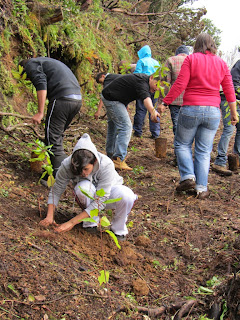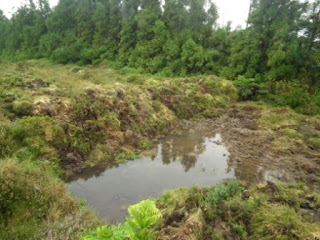The Life Sustainable Laurel Forest project, coordinated by SPEA in partnership with the Regional Secretariat of the Environment and the Sea and with the City Council of Povoação, presented part of the work carried through in Serra da Tronqueira and Planalto dos Graminhais in the seminary “Conservation of Habitats authochthonous and control of invading exotic species” that was held until last sunday in Luso, Mealhada.
This seminary organized by the Mata do Buçado Foundation (FMB), in the scope of the LIFE BRIGHT, had as objective to commemorate the Authochthonous Forest Day and joined representatives of some of the main projects for the natural recovery of habitats and control of vegetal species of exotic invaders taking place in the Portuguese territory.
Joaquim Teodósio, the LIFE coordinator, presented two sources of the work done. In the first day a boarding on the different functions that the greenhouse plays, where, besides the production of plants for the recovery of the habitats, if it approached the component of spreading and support to the schools (mainly of the EBS of Povoação), volunteering and the tourism and the economic and landscape value of the species from the original forest of the Azores.
On the second day, it was presented the work carried through since 2003 in the recovery of the natural habitats of Serra da Tronqueira and Planalto dos Graminhais, namely the Laurel Foresta and the peatbogs. This work has passed through an extended control of diverse exotic invading flora species. The good results and the dimension of the work with about 350 ha of habitats recovered were the two factors highlited by some of the participants of this seminary.
Throughout the Seminary it were presented results from other works carried through in Portugal, aiming the control of invading vegetal species as the Acacia Wood and the sugar cane that threaten many of the natural forest areas of Portugal. The FMB also presented the work of LIFE Bright Project, taking place in Mata do Buçado for recovery of the Adernal, an old and rare forest, threatened by the proliferation of Acacia's wood and the Australian Cheesewood. It was also possible to visit some of the interventioned areas of this project.
From the part of the LIFE Sustainable Laurel Forest we are greatful for the invitation and shelter on the part of the FMB, as well as the congratulations for this excellent initiative.
To know more about this seminary and the subjects treated visit HERE.

























.JPG)
.JPG)












.JPG)
.JPG)
.JPG)
.JPG)
.JPG)










